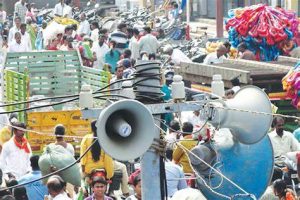 By Biswaraj Patnaik in Puri, December 16, 2021: Way back around the turn of the millennium, a German, who loved to spend time holidaying in the cool, calm temple town of Puri on sea between winter and spring every year was heard declaring ruefully to the local friends about his decision to never ever return to the horrifically metamorphosed town. The sole reason was that the place had lost the beauty of silence.
By Biswaraj Patnaik in Puri, December 16, 2021: Way back around the turn of the millennium, a German, who loved to spend time holidaying in the cool, calm temple town of Puri on sea between winter and spring every year was heard declaring ruefully to the local friends about his decision to never ever return to the horrifically metamorphosed town. The sole reason was that the place had lost the beauty of silence.
Cycle rickshaws had been replaced by noisy and carbon-spewing diesel auto rickshaws. He would go on to explain how a civilised society respected a noise free environment. Carbon chain was bad but noise as life destroyer was worse as its impact was instant. Ambient noise would make people sick and the living world weak. Birds and animals would not procreate as they come under enormous stress. In consequence, thousands of plant species go extinct as propagating-courier animals and birds would be gone.
Most environmentalists scream like crazy about deteriorating quality of air and the waters of oceans and rivers. But hardly any of these would whimper once against noise pollution which is killing everyone everywhere and at any given point in time. Human beings are bound to take big beating on many fronts as loud noise causes:
severe Hypertension and increased pulse rates
hearing loss
concentration loss at work place or studies.
irritation and headache.
Sleep disturbances
irritability, anxiety, and mental fatigue, and interference with recreation, and personal communication.
Loudness or sound pressure level is measured in logarithmic units called decibels (dB). The ambient SPL in a fairly noiseless library is about 35 dB, while inside a moving bus or subway train that is roughly 85 dB; building construction activities can generate SPLs as high as 105 dB at the source.
Because of the logarithmic nature of the decibel scale, an increase of 10 dB represents a 10-fold increase in sound intensity, an increase of 20 dB represents a 100-fold increase, a 30-dB increase represents a 1,000-fold increase in intensity, and so on. When sound intensity is doubled, on the other hand, the SPL increases by only 3 dB.
 Noise pollution impacts wildlife very adversely. Insects, frogs, birds, and bats lose the ability to attract a mate, communicate, navigate, find food, or avoid predators and thus can even be an existential threat to vulnerable organisms. Even marine animals, particularly whales and dolphins that rely on echolocation suffer hugely as the world’s oceans are polluted with chaotic sounds from ships, seismic tests, and oil drills and sonar devices creating noise that can travel hundreds of miles through the water.
Noise pollution impacts wildlife very adversely. Insects, frogs, birds, and bats lose the ability to attract a mate, communicate, navigate, find food, or avoid predators and thus can even be an existential threat to vulnerable organisms. Even marine animals, particularly whales and dolphins that rely on echolocation suffer hugely as the world’s oceans are polluted with chaotic sounds from ships, seismic tests, and oil drills and sonar devices creating noise that can travel hundreds of miles through the water.
The CPCB has laid down the permissible noise levels in India for different areas for both daytime and night time.
In industrial areas it has fixed 75 dB for daytime and 70 dB at night while in commercial areas it has to be lower than 65 dB and 55 dB. Most significantly in residential areas it is 55 dB and 45 dB during daytime and night respectively, which is violated the most as residents are timid, or law-ignorant or where the law enforcers particularly the police are callous and casual without being aware that they can be pulled up heavily by courts if provoked.
Governments all over have declared ‘silent zones’ which include areas that lie within 100 meters of the premises of schools, colleges, hospitals and courts. The permissible noise limit in this zone is 50 dB during the day and 40 dB during the night. So obviously governments are expected to take measures for abatement of noise emanating from vehicles blowing air horns, bursting of crackers, use of loud speakers or public address system and worst of all sound producing instruments dutifully to ensure that the noise levels do not exceed the ambient quality standards as specified under the rules.
Needles to say development authorities, local bodies and other concerned authorities while planning developmental activity or carrying out functions relating to urban and countryside planning have to consider all aspects of noise pollution as a parameter of quality of life.
The law enforcement agencies are bound to take action against offenders specifically in the event of a public complaint by putting in place dedicated desks to take complaints and act instantly.
Thumb rules ordinary citizens must know to exercise their rights for getting the entitled relief:
• Loud speaker or a public address system shall not be used except after obtaining written permission from the concerned authority.
• No sound producing instrument-musical, or electronic sound amplifier shall be used at night time except in closed premises for communication within auditorium, conference rooms, community halls, banquet halls or during a public emergency.
Use of loud speakers during night hours (between 10.00 p.m. to 12.00 midnight) on or during any cultural or religious festive occasion of a limited duration not exceeding fifteen days in a calendar year may be allowed under strict public policing mode.
The noise level at the boundary of the public place, where loudspeaker or public address system or any other noise source is being used shall not exceed 10 dB above the ambient noise standards permissible for the area.
 The peripheral noise level of a privately owned sound system shall not exceed by more than 5 dB of the permissible ambient noise standards. But shockingly, apart from the always seen and heard explosive amplified music played by wedding processions, people in restricted residential locations too blast speakers day and night at the drop of a hat. One is victim to lethal noise every now and then- Welcoming a new baby and a girl attaining puberty are celebrated with ear-splitting movie songs; and similarly bhajans blasting at jet engine decibel levels during the the last rites event of a deceased person. All these are criminal acts and heavily punishable.
The peripheral noise level of a privately owned sound system shall not exceed by more than 5 dB of the permissible ambient noise standards. But shockingly, apart from the always seen and heard explosive amplified music played by wedding processions, people in restricted residential locations too blast speakers day and night at the drop of a hat. One is victim to lethal noise every now and then- Welcoming a new baby and a girl attaining puberty are celebrated with ear-splitting movie songs; and similarly bhajans blasting at jet engine decibel levels during the the last rites event of a deceased person. All these are criminal acts and heavily punishable.
Penalty for violators should be known to all :
• Under the new system of fines, a violation of norms over the use of loudspeakers / public address systems can result in the confiscation of equipment and a fine of Rs 10,000.
• Noisy diesel generator sets can be sealed with a fine between Rs 10,000 and Rs 100,000 depending on the size of the set.
• Sound-emitting construction equipment can result in a fine of Rs 50,000 and its seizure or sealing.
Interestingly, concerned authorities not acting on individual or public complaint can be fittingly penalised. The media must be kept alert to publicize dereliction of duty.
Every civilised state has stringent rules in place for complete prevention of noise pollution. Only in loosely governed countries, kingdoms or provinces, ‘the rule of law’ is only a joke. Authorities there steal fat salaries to cause distress to citizens rather than ensuring relief for them.



Leave a Reply
Be the First to Comment!